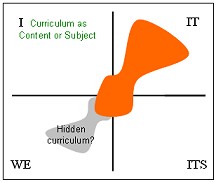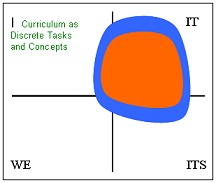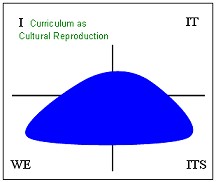Curriculum as Connectivism
I've been reading with interest George Siemen's blog and wiki on 'connectivism' talking about learning as network creation and how we might provide 'learning ecologies' to meet the needs of students. I'm finding these concepts very useful as we look at planning the implementation of the new Curriculum Framework. But before I launch into that I've been trying to place connectivism as a curriculum metaphor within an Integral AQAL Framework... particularly after reading his last post revisiting a discussion on subjectivity and objectivity.I've looked at this before with some simplistic (perhaps too simplistic) mappings of other curriculum metaphors onto Ken Wilber's subjective/objective/individual/collective quadrants (270Kb). The different colours refer to waves from Spiral Dynamics... Blue as rule-self, orange as achiever-self, green as sensitive-self, yellow as integral-self... but I'm mostly interested in which quadrants these metaphors map into... at least in the way they have usually been implemented.
 Curriculum as Content or Subjects: This metaphor portrays a traditional image of curriculum that stretches back to Pythagoras and Plato. This curriculum is one which receives contents from traditional academic disciplines and transmits them to the learner.
Curriculum as Content or Subjects: This metaphor portrays a traditional image of curriculum that stretches back to Pythagoras and Plato. This curriculum is one which receives contents from traditional academic disciplines and transmits them to the learner.Intent: Curriculum development centres largely on subjects, contents, timetables and booklists. Needs may be defined in terms of preparation for university, commerce or general study.
Criticism: Does not account for cognitive development, creative expression, and personal growth. Nor for planned and un-planned activities that are a major part of students’ experiences at school.
 Curriculum as Discrete Tasks and Concepts: The curriculum is seen as a set of tasks to be mastered and is derived from training programs in business, industry and the military.
Curriculum as Discrete Tasks and Concepts: The curriculum is seen as a set of tasks to be mastered and is derived from training programs in business, industry and the military.Intent: ‘Apprenticeship’ with an adult to gain certain knowledge and skills.
Criticism: Does not prepare the learner for a changing world. Suited to technical training rather than conceptual understanding.
 Curriculum as Experience: This image of curriculum, following John Dewey, emphasizes experience rather than sets of activities. Learners select a learning experience according to its significance in their life.
Curriculum as Experience: This image of curriculum, following John Dewey, emphasizes experience rather than sets of activities. Learners select a learning experience according to its significance in their life.Intent: With this notion of curriculum, the learners have a key role in curriculum process. Experiences are created as learners reflect on the learning process.
Criticism: Students’ involvement in planning and selecting the learning experiences is very idealistic - they may not be able to decide which is of significance and which is not. How do you implement this in a large school?
 Curriculum as Cultural Reproduction: The curriculum metaphor is concerned with the notion of transmission of cultural knowledge and values from one generation to another.
Curriculum as Cultural Reproduction: The curriculum metaphor is concerned with the notion of transmission of cultural knowledge and values from one generation to another.Intent: To prepare the youth for the culture of a certain community, state and country.
Criticism: Helps maintain the status quo by transmitting middle class culture rather than that of the oppressed. Does not help develop critical thinking.
 Curriculum as “Currere”: The curriculum is the interpretation of the learner’s lived experiences – the learner comes to understand their past, how it drives the present and how it directs the future of their personal and professional life. Individuals come to a greater understanding of themselves, others, and the world about them.
Curriculum as “Currere”: The curriculum is the interpretation of the learner’s lived experiences – the learner comes to understand their past, how it drives the present and how it directs the future of their personal and professional life. Individuals come to a greater understanding of themselves, others, and the world about them.Intent: Freedom from unwarranted convention, ideology and labelling. To mutually fashion new directions for oneself, others and the world.
Criticism: Self-understanding is a parental responsibility. The search for self-knowledge requires professional therapists.
 Curriculum as Intended Learning Outcomes: This image sees the curriculum as a process of goal setting and drawing a pathways to those goals. The outcomes are expressed in general terms like “understanding the value of…”. Today most curriculum frameworks have incorporated this image.
Curriculum as Intended Learning Outcomes: This image sees the curriculum as a process of goal setting and drawing a pathways to those goals. The outcomes are expressed in general terms like “understanding the value of…”. Today most curriculum frameworks have incorporated this image.Intent: The curriculum is explicit and defensible. Teachers and students can determine their learning activities according to their needs and locale.
Criticism: Draws attention away from unintended outcomes relating to school culture and the hidden curriculum.
So... how does one map curriculum as connectivism? At the moment my reading places it mainly in the ITS quadrant - grounded in an objective systemic worldview but taking into account issues of social constructivism (WE quadrant) with a span across blue/orange/green and possibly into yellow memes. A much broader span than the other metaphors...
 Curriculum as Connectivism: This curriculum metaphor is related to networks and network topology. It takes a systems view of learners and sees learning as network creation.
Curriculum as Connectivism: This curriculum metaphor is related to networks and network topology. It takes a systems view of learners and sees learning as network creation.Intent: To provide a ‘learning ecology’ that the student connects with as and when appropriate.
Criticism: Favours self-directed learners.
This is potentially a richer way of seeing curriculum provision and I'm now interested to see how this metaphor might inform our discussion of how students choose their learning, what structures we might put in place to provide learning ecologies and how we can support students to make the necessary connections... more on this later.
Our leadership team have already found Sieman's Learning in Context powerpoint very useful (see also this pdf paper) and I'm hoping to see him in Sydney later this year...
The above curriculum metaphors (apart from the last one) are sourced from: Schubert, W. H. (1986). Curriculum: Perspective, Paradigm, and Possibility. New York: Macmillan Publishing Company.
Labels: conceptual frameworks, curriculum, integral




6 Comments:
Hi Roger...tried sending this via email, but it bounced...
Thanks for your recent post on “curriculum as connectivism”. I think you’ve captured what I’m trying to say/do with connectivism – namely that learning itself is too rich and is comprised of too many dimensions to be adequately explained through traditional theories and views. I would like to dialogue with you on this if your schedule/interest permit. Do you use skype? My handle is “gsiemens”. My next few weeks are fairly open…perhaps we can connect (once we figure out time zone differences J).
George
Interesting. I wonder how AQAL would apply to various learning theories.
george - thanks will make contact soon... I think the 'stages and lines' concept from AQAL has much to offer education as well...
downes - mapping learning theories onto AQAL is something I've had a bit of a look at... I'll post something on it soon.
jo mcleay - thanks jo - I'll add myself... I've wanted to have a play with Frappr as well and I see International Edubloggers uses that service so that might be fun :-)
Hi Roger
I was reading your blogg from june 13. your curriculum as connectivism and I find it very interesting but I do not understand the labels on your pictures, that is what you mean by: I, IT, WE, ITS. Would you please be kind to explain it to me.
Hi from Iceland Gerda
Hi Gerda
4 Quadrant Integral Theory —refers to the fact that all major human languages have first-, second-, and third-person pronouns (for example: I, you/we, and it). If we realize that "it" can appear in plural, or "its" then we have the "four quadrants" or dimensions that are present in all major human languages: I, we, it, and its—or the intentional, cultural, behavioural, and social dimensions of all human beings.
You can read more here...
and I have some narrated slides here (forum links are not active at the moment)
See also the Integral Institute
Thanks for this post. I have just started thinking about how connectivism fits (or not as the case may be)with learning outcomes and curriculum, and your post has really helped my clarify some issues - thanks.
Post a Comment
<< Home